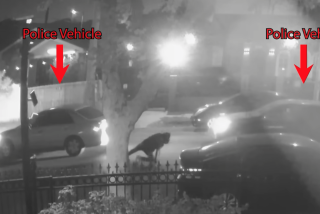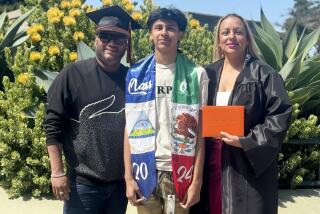Shooting Scenes Were Doctored, Perez Says
Rafael Perez, who has told investigators that he helped cover up three unjustified shootings, has said that he knows of at least five others in which Los Angeles Police Department officers and their supervisors doctored shooting scenes to conceal their mistakes.
In one case, in which a rookie cop allegedly overreacted and shot an unarmed man hiding in a closet, a supervisor splattered ketchup around the scene and concocted a tale that the young officer thought it was blood and believed he was in imminent danger of being shot. “They wanted to save the kid’s career,” former LAPD officer Perez told investigators. “They asked him, ‘What do you got?’ And he said, ‘I don’t know. I just shot him.’ And they were like, ‘Oh, Jesus.’ ”
In a similar case, a supervisor allegedly planted a piece of scrap metal next to a juvenile shot at by an officer who incorrectly thought he was armed. The metal, taken from a nearby car, was used to support the officer’s claim that she thought she saw a gun when she fired, Perez told investigators, according to transcripts of interviews obtained by The Times.
In that case, the suspect was not hit. “The guy just stops and falls to the ground, like ‘holy smokes, you know, I give . . . don’t shoot at me,’ ” Perez said.
Investigators on the department’s corruption task force are looking into at least seven questionable officer-involved shootings. The detectives are scrutinizing not only the involved officers’ actions, but also the roles of their supervisors, as well as those of the special teams that investigate such incidents.
Perez, who is cooperating with investigators in exchange for a lighter sentence for stealing eight pounds of cocaine from LAPD evidence facilities, has implicated himself and his former partner in the shooting of an unarmed 19-year-old man.
The ex-cop told investigators that he and Nino Durden shot Javier Ovando multiple times, then planted a gun on him and testified falsely in court that he had attacked them. Ovando, who was convicted and sentenced to 23 years in prison, has since been freed and is suing the city. Perez has also told investigators that he either witnessed or helped cover up two other bad shootings by fellow Rampart CRASH officers, including one in which a 21-year-old man was killed.
To date, more than 70 LAPD officers are under investigation for either committing crimes or knowing about them and helping to cover them up, according to document obtained by The Times. Dozens of people who were allegedly framed by the police have had their cases thrown out of court in the wake of the scandal, the LAPD’s worst ever.
According to interview transcripts, Perez said a sergeant once told him and other CRASH officers during a roll-call meeting that a shooting involving a probationary officer in Rampart was covered up so the young officer wouldn’t lose his job.
Perez said the officer was searching an apartment and pushed open a closet door to find a man hiding inside. The officer apparently was startled and fired one round at the man, striking him in the stomach.
When a pair of sergeants arrived, Perez alleges that they fabricated a story in an attempt to justify the officer’s action. In addition to throwing ketchup on the wall, the sergeants came up with the idea of saying the victim was holding a small mirror and when the officer opened the closet door and aimed his flashlight inside, he saw his own reflection and thought he was under attack.
Perez said the sergeant at roll call “made it very clear to us that that was just what they did to save, you know, his job.”
“And what they did,” said Det. Michael Hohan, “was. . . .”
“Was just cover it up,” Perez replied. “Fixed it. You know, uh, fixed it for the kid so he didn’t get fired.”
Perez did not remember the name of the probationary officer. A 1996 LAPD shooting report that matches some elements of Perez’s story found that the shooting was accidental, but that the use of force was improper. A summary of the complete shooting investigation report made no mention of the ketchup or the mirror.
Another scene was allegedly staged after a shooting in the early morning hours of March 26, 1995, Perez said.
According to LAPD documents, Officers Melissa Town and Robert Valdez were searching for a murder suspect when they saw a group of young men near the intersection of Maltman and Bellevue avenues. One of them matched the description of the shooter, whose photograph the officers had in their car, according to an LAPD summary of the shooting. The officers also knew that the murder weapon was a semiautomatic pistol.
“Officer Town made eye contact with [the suspect] who then grabbed a chrome object from his waistband. Officer Town believed the chrome object was a pistol,” the summary states. “Officer Valdez said to Officer Town, ‘He has a gun!’ ”
After a brief foot chase, Town encountered the suspect running toward her. She lighted her flashlight, identified herself and ordered him to stop, the shooting summary states.
“[The suspect] continued running toward Officer Town and pointed what the officer perceived to be a chrome handgun at her. In immediate defense of her life, Officer Town fired one round from her 9-millimeter pistol.” According to the shooting report, what Town said she thought was a gun was a 5 1/2-inch piece of curved chrome molding.
Perez gave a starkly different account of the shooting to task force investigators.
“From what I understand she just kind of overreacted and shot a round,” Perez said, adding that he was later told about the incident by a sergeant at a roll call.
Perez said two sergeants at the scene huddled and discussed how to handle the incident. One of the sergeants, he said, saw a piece of metal sitting on the bumper of a nearby car. The sergeant picked it up and put it on the ground next to where the victim fell. Then he turned to the officer, Perez said.
“OK, that’s what he had in his hand. And then, he pointed it at you,” Perez quoted the sergeant as saying to Town. “And that’s how that one went.”
Perez also talked about an officer-involved shooting detailed in The Times in December and already under investigation by task force detectives. In that case, 44-year-old Carlos Vertiz, a man with no criminal record, was fatally shot in the basement of his apartment building after he allegedly pointed a shotgun at Officers Frank Galindo and Ruben Palomares. The officers fired 10 shots at Vertiz, who never fired his weapon, according to an LAPD summary of the shooting. Witnesses interviewed by detectives who have reopened the case told The Times that investigators appeared to be pursuing the theory that Vertiz was mistaken for a drug dealer the officers where searching for the day of the shooting.
Perez said he discussed the shooting over beers with the officers involved.
“Supposedly, there was a shotgun put there,” Perez said. “Which officer did what, I don’t know.”
“The general consensus was the shotgun was planted? Is that correct?” asked Hohan, the task force investigator.
“Right,” Perez said.
Perez told task force detectives about two other shootings that he said were widely known to be unjustified in CRASH circles. The shootings, he said, were discussed among CRASH officers at the Short Stop bar on Sunset Boulevard and “the benches” at the Los Angeles Police Academy, two favorite spots for officers to unwind and drink beer.
“We talk about how things went down. How they really went down and how they were fixed up,” Perez said.
He talked about one case involving an officer who was working narcotics. “Supposedly . . . the suspect went after his gun, when actually he was running after the guy and the gun went off accidentally.” Perez identified the officer involved, but offered no other details about the case.
Another reputedly bad shooting involved an officer from 77th CRASH, Perez alleged. In that case, “The guy falls or something--gets shot. And then, they clean it up. That’s what I heard. That’s what we talked about,” Perez told detectives. “I don’t know why they would say they cleaned it up [if] it was actually a good shooting, you know what I mean?”
More to Read
Sign up for Essential California
The most important California stories and recommendations in your inbox every morning.
You may occasionally receive promotional content from the Los Angeles Times.











